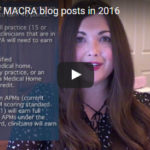 With only 10 shopping days left before Christmas, I thought we would add one more item to your year-end to-do list. Last week Diana Strubler walked us through a very nice review of the current status of MU Stage 3. One important point she made was the substantial attrition rate among nephrologists reporting MU in 2014. Almost 4,000 nephrologists attested in 2012 and the following year that number peaked at roughly 4,800. But last year the number of nephrologists successfully attesting plummeted to less than 1,800. What accounts for a 60% drop in participation by nephrology? In a word, hardship. Sure there could be a few docs who were willing to take the 2% Part B book of business haircut in 2016, or perhaps a few who planned to retire between now and then. But the bulk of this attrition is almost certainly made up of nephrologists who successfully filed for one of the MU hardship exceptions.
With only 10 shopping days left before Christmas, I thought we would add one more item to your year-end to-do list. Last week Diana Strubler walked us through a very nice review of the current status of MU Stage 3. One important point she made was the substantial attrition rate among nephrologists reporting MU in 2014. Almost 4,000 nephrologists attested in 2012 and the following year that number peaked at roughly 4,800. But last year the number of nephrologists successfully attesting plummeted to less than 1,800. What accounts for a 60% drop in participation by nephrology? In a word, hardship. Sure there could be a few docs who were willing to take the 2% Part B book of business haircut in 2016, or perhaps a few who planned to retire between now and then. But the bulk of this attrition is almost certainly made up of nephrologists who successfully filed for one of the MU hardship exceptions.
Intent of the Exceptions
The hardship exceptions were established in 2012, ahead of 2015, of the first payment adjustment year. This year represents the first year CMS has penalized providers for not being meaningful users of a Certified EHR. Health and Human Services recognized that in specific circumstances, complying with the meaningful use requirements would create a hardship for providers. Quoting from the recently published meaningful use final rule:
“As stated previously, sections 1848(a)(7)(B) and 1886(b)(3)(B)(ix)(II) of the Act provide the Secretary with discretionary authority to exempt, on a case by case basis, a provider from the application of the Medicare payment adjustment if the Secretary determines that compliance with the requirements for being a meaningful EHR user would result in a significant hardship.”
Given the patient population we care for and the accompanying workflow involving unique venues of care, it should come as no surprise that “compliance with the requirements for being a meaningful EHR user would result in a significant hardship” for many nephrologists. Couple this with the fact that the bulk of the financial incentives for this program have been paid, and that moving forward, attesting for MU is all about avoiding penalties, I would be surprised if participation by nephrologists does not continue to decline.
The Options
Most of these nephrologists likely filed for the “50% rule” hardship exception. We’ve reviewed that before and for those of you looking for a deeper dive, I’d encourage you to look here. At a very high level, this exception is used when more than half of your outpatient encounters occur in a venue of care that’s not equipped with a certified EHR, and the nephrologist does not have direct control over the decision to deploy a certified EHR in that venue of care. This is a common circumstance among nephrologists who spend a lot of time in either a dialysis facility or a vascular access center.
But this year, CMS has served up another option for us to consider. Remarkably, the final rule was published on October 6 of this year. Prior to that date, no one knew what was expected to satisfy MU reporting for CY 2015. The press release announcing the release of the final rule is worth a close read. I’ve reproduced part of it below:
“In the interim, although the majority of physicians have not received negative payment adjustments under Medicare, we know that some physicians are not ready to qualify for the EHR Incentive Programs and are concerned about these adjustments. We intend to use our administrative flexibility as much as we can to help physicians and other providers who are making efforts to adopt and use this technology to succeed. We encourage providers to submit requests for a significant hardship exception from the payment adjustment through the existing request process. We are pleased that most providers have been successful in adopting and using the technology and we want to work with those who are still transitioning to the use of EHRs.”
I have bolded and underlined the section I had to read twice, but yes in fact CMS is encouraging you to submit a hardship exception. In fact, the tardy release of the final rule has many considering applying for the hardship exception labelled “Unforeseen Circumstances”. Historically, the best examples for using this exception were in instances of natural disasters or the much more common circumstance in which a provider switches EHRs midyear (either because their practice switched EHRs or the doc left one practice and joined another). But this year, because no one knew what to expect until October 6, one could make the case that this delay constitutes an Unforeseen Circumstance. After all, the last 90-day reporting period for 2015 started before October 6!
Hurry up and wait
The 2015 reporting period represents the 2017 payment adjustment period for everyone except those who have never participated in the program. If you do not successfully attest for MU in 2015, or successfully file for a hardship exception prior to the deadline, CMS will impose a 3% penalty on your entire Part B book of business during 2017. The deadline to file for the applicable hardship is July 1, 2016, and there is no use looking for the hardship application because it has not been posted yet. I do not anticipate seeing it on the CMS web site until after the first of the year.
One other point to consider, and again I quote from the recently published final rule: “The exception is subject to annual renewal, but in no case may an EP be granted an exception for more than 5 years.”
This is part of the statute and therefore it is unlikely to change. But with the release of MACRA and the establishment of MIPS, the stand-alone MU program will be sunset at the end of 2018, so the last penalty to avoid for the current MU program is a function of what you do in 2016. Stated another way, no one will use the exception as it exists today more than 5 times.
Happy Holidays
As the year comes to a close, all of us have a number of last-minute tasks on our “to do” lists. Yours truly typically puts off holiday shopping until the last minute (nothing like a little pressure). Consider this post an early treat in your Christmas stocking. I hope it reduces some of the stress that tends to accumulate towards the end of year. If you intend to file for a hardship exception for CY 2015, you have plenty of time and a number of options. As you prepare for the weeks ahead, beyond this stocking stuffer, all of us at the Acumen blog would like to wish you and your family a safe and joyful holiday season.
 Terry Ketchersid, MD, MBA, practiced nephrology for 15 years before spending the past seven years at Acumen focused on the Health IT needs of nephrologists. He currently holds the position of Chief Medical Officer for the Integrated Care Group at Fresenius Medical Care North America where he leverages his passion for Health IT to problem solve the coordination of care for the complex patient population served by the enterprise.
Terry Ketchersid, MD, MBA, practiced nephrology for 15 years before spending the past seven years at Acumen focused on the Health IT needs of nephrologists. He currently holds the position of Chief Medical Officer for the Integrated Care Group at Fresenius Medical Care North America where he leverages his passion for Health IT to problem solve the coordination of care for the complex patient population served by the enterprise.




Leave a Reply